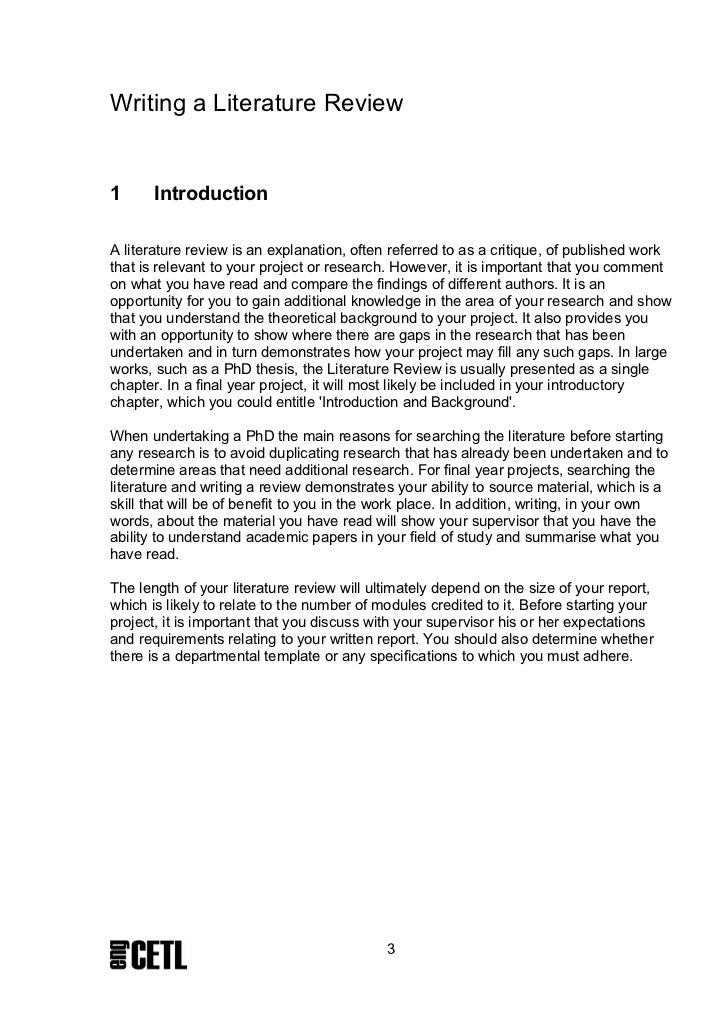
A literature review is a document or section of a document that collects key sources on a topic and discusses those sources in conversation with each other (also called synthesis). The lit review is an important genre in many disciplines, not just literature (i.e., the study of works of literature such as novels and plays) · When I undertook the task of writing a scientific literature review article last year, I had hoped that a Google search would reveal a handful of how-to pages thoughtfully created by veterans of this particular writing process. I found nothing of the sort, so I plowed ahead on my own, inventing techniques for myself Writing a review article is a wonderful way to develop and exercise your scientist skill set. If you dread the thought of writing a review, or if you’re currently stuck trying to write one, hopefully this post will help you get things moving - remember you're becoming an expert in your field and are the perfect person to be writing the review!
How to Write a Scientific Review Article
When I undertook the task of writing a scientific literature review article last year, writing a scientific literature review, I had hoped that a Google search would reveal a handful of how-to pages thoughtfully writing a scientific literature review by veterans of this particular writing process.
I found nothing of the sort, so I plowed ahead on my own, inventing techniques for myself. I was running a protein over a nickel column on a Sunday evening in February when my adviser approached me about co-authoring a review article for Annual Review of Biochemistry.
That was fine with me — as a fifth-year graduate student, I had learned to cope with, and even prefer, extreme independence. To be honest, I was excited to have this opportunity to examine the literature in depth and to create something useful out of it. Our topic was caspase substrates, a diverse group of proteins essential for programmed cell death and thus important to our understanding of how to kill cancer cells.
I would have to assess the limits imposed by the journal 30 pages, six months as well as my own limits and the necessity to balance the writing project with lab work that was essential to finishing my Ph.
Narrowing the scope of the article to conform to these boundaries was perhaps the biggest challenge of this process. Knowing that I work better when I focus on one project at a time, I spent the next two months carrying out all of my regular lab work while only pondering the review article and skimming the literature when I had time.
After that, I transitioned to full-time reading and writing. I found a café that I liked in my neighborhood and spent nearly every morning there that summer drinking tea, eating pumpkin muffins and working on my laptop. Afternoons I often spent writing at my apartment or at the library on campus. I tried to reassure myself by remembering that I had been rather good at writing term papers in college; but this was a larger task and one with the potential for having an impact on someone, somewhere, sometime who wanted to learn about caspase substrates.
In the end, I finished by the deadline well, plus one two-week extension the editor agreed to grant me and was very happy with the product and with all I had learned about caspase substrates, about the scientific literature and about the review-writing process. I hope the following tips will help other scientists who find themselves in this kind of uncharted territory, writing a scientific literature review.
Distilling all sorts of data from experiments done by scientists all around the world into a coherent story turned out to be very satisfying. I look forward to doing it again someday, perhaps in a somewhat more efficient manner.
Emily Crawford was a graduate student at the University of California, San Francisco, when she wrote this article. Happening this week: The ASBMB annual meeting! See our tips for preparing and our highlights of networking opportunities. Our writing a scientific literature review careers columnist talked to Jason Howard, who works in the medical affairs department of Sanofi Genzyme, a company that develops therapies for patients with rare diseases.
Happening this week: Free webinars on building relationships, telling your science story and biological aging. Three science illustrators discuss how they have merged their academic training in research with a lifelong interest in the visual arts. ASBMB Today Careers Tips for writing your first scientific literature review article.
By Writing a scientific literature review Crawford. Emily Crawford often retreated to her apartment rooftop in San Francisco to write her review. Photo courtesy of Matthew Perry. Getting started Our topic was caspase substrates, writing a scientific literature review, a diverse group of proteins essential for programmed cell death and thus important to our understanding of how to kill cancer cells.
Define the scope of the article. Make an outline, keep lists of topics that are and are not within your scope, and remind yourself to stop any time your reading wanders outside your scope. My adviser and I settled on devoting the first half of our article to a broad survey of a few key research topics for example, the physical details of the caspase-substrate interaction and devoting the second half to a few highly detailed vignettes about some of the hundreds of known caspase substrates.
Your labmates and collaborators are invaluable resources. Be careful not to let this lead you too far astray. Look for areas that have not yet been thoroughly reviewed or areas for which you think you have a fresh take on old data. Make yourself comfortable. Find places to write where you can concentrate, and take breaks often to stretch, get a snack or even step outside for a few minutes.
On days when I struggled with concentration, writing a scientific literature review, I often used a timer to structure my day. I would work for 60 minutes, then take a sanity break, then work for another 60 minutes, and on and on.
Impose some structure on the mess that is the scientific literature. I developed a strategy for each research topic that I wanted to review including the broad survey section in the first half and the vignette sections in the second half. First, I found the most recent papers on the topic and went through them, picking out what looked like important references, writing a scientific literature review. I worked my way backward to a set of about 10 key papers.
Then I quickly read and made a summary for each, usually in the form of writing a scientific literature review bulleted list of the conclusions drawn from each figure. Next, I combined those summaries into a single table. I did this by hand on paper; writing a scientific literature review Excel writing a scientific literature review also would work.
Each research article was one row arranged by publication dateand the columns were results or conclusions reached. I then easily could see which papers agreed on which topics, what trends emerged over time and where the controversies in the field lay. I found that once I had made a table, the narrative of that particular research topic almost wrote itself. Spend some time writing with all your PDFs and Web browsers closed and your desk cleared of any paper.
This was advice my adviser gave me about a month before the due date, when he could tell that my brain and my PDF library were so overflowing with data that I was struggling with actually producing any text.
On the other hand, with the Internet and all my PDFs in front of me, I tended to generate sentences that were very dense with information but not necessarily closely related to each other — and not always pertinent to the specific scientific narratives I was attempting to compose.
I started making real progress on the writing only when I spent a few August afternoons sitting on the roof deck of my apartment building with a pen and paper and no Internet-capable writing a scientific literature review. Yes, I sometimes wrote things that were wrong or at least imperfect when constructing a section from memory. However, I often ended up with a strong scaffolding onto which I could later add some of those dense, fact-laden sentences.
This was easy in my case, because my adviser and I both preferred that I be the main researcher and writer and that he act as a consultant on high-level issues, writing a scientific literature review. However, I am keenly aware of other cases that did not work out nearly as congenially. Pay very close attention to the graphical requirements for figures.
Make sure to get permission to reproduce any figures in your review. This usually is done by following the permissions instructions on the website of the journal in which the original figure appeared. Get familiar with software like Papers or any other PDF-management softwareEndNote and Adobe Illustrator or whatever graphics program the journal suggests. Your labmates and collaborators also can help you with the editing process.
Rather than asking one or two people to help you edit the entire article, break it up into sections and ask a different colleague for his or her expert help in revising just one section on a topic with which you know he or she is familiar.
Another strategy is to give part or all of your article to a first-year graduate student or to a scientist in a slightly different field. He or she is your target audience and will let you know if there are sections that need to be revised for clarity. Contribute your story. Related articles Tips and tricks for writing great conference abstracts Martin J.
Finding the right fit Rachel Fairbank. A molecular biologist by day and a science artist by night Martina G. Meet Josseline Ramos—Figueroa Angela Hopp. Meet Danielle Schmitt Angela Hopp. Featured jobs from the ASBMB career center. Join the ASBMB Today mailing list Sign up to get updates on articles, interviews and events.
Read More.
How to Write A Literature Review? From Blank Page to Plan! - PhD Thesis Writing (Episode #5)
, time: 11:03Writing a Literature Review // Purdue Writing Lab

A literature review is a document or section of a document that collects key sources on a topic and discusses those sources in conversation with each other (also called synthesis). The lit review is an important genre in many disciplines, not just literature (i.e., the study of works of literature such as novels and plays) A scientific literature review is a critical account of what has been published on a topic by accredited researchers. It may be: • A stand-alone assignment • An introduction to an essay, report, thesis, etc. • Part of research/grant proposals. Scientific Literature Review: Writing a literature review will: • Improve your topic knowledge • Provide new insight on your topic to others • Demonstrate your literature File Size: 1MB Writing a review article is a wonderful way to develop and exercise your scientist skill set. If you dread the thought of writing a review, or if you’re currently stuck trying to write one, hopefully this post will help you get things moving - remember you're becoming an expert in your field and are the perfect person to be writing the review!

No comments:
Post a Comment